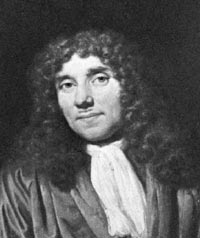
| Born: Oct 24, 1632 in Delft, Dutch Republic |
| Died: Aug 26, 1723 (at age 90) in Delft, Dutch Republic |
| Nationality: Dutch |
Antonie van Leeuwenhoek was a scientist from the Netherlands. He is known as the first microbiologist and also “the Father of Microbiology” because he was the first to observe bacteria underneath a microscope. He made many other significant discoveries in the field of biology and also made important changes to the microscope.
Early Years and Personal Life
He was born in Holland, in the city of Delft, in October of 1632. His father was a basket maker and his mother came from a successful brewer’s family. Little is known about his early life except that he went to school near Leyden before he went to live with his uncle in Benthuizen. At the age of 16, he was an apprentice for a linen-draper’s shop.
In July of 1654, Leeuwenhoek wed Barbara de Mey and they had five children, but only a daughter survived. After getting married, he returned to Delft and stayed there for the remainder of his life. Leeuwenhoek opened and operated his own draper’s shop during the 1650s. His wife died in 1666, and Leeuwenhoek remarried five years later. He was a very well-known figure in Delft and received a municipal title for the city’s sheriff’s assembly chamber, a position that he held for nearly 40 years.
Invention of Microscopic Lenses
Leeuwenhoek developed a fascination with lens-making while he was working at his shop. His interest in microscopes, as well as his knowledge of glass processing, resulted in a very significant and technical discovery in the field of science.
He learned that he could place the middle part of a small rod of lime soda glass into a very hot flame and then pull the hot glass apart to make two long strands of glass. Then, he reinserted the end of one strand in the flame to make a small glass sphere that was of high quality. He found that the smallest lenses rendered the highest magnifications and these spheres soon became lenses for his microscopes.
According to some reports, Leeuwenhoek is believed to have made over 200 microscopes that had various magnifications, but only a few of them survived. He also made over 500 optical lenses. He used copper or silver to make the frames for his microscopes. The lenses that have endured are able to magnify objects up to 275 times.
Scientific Significance
At the end of the 17th century, Leeuwenhoek had a monopoly on microscopic research and discovery. Over the years, he was visited by many prominent individuals, including Peter the Great, a Russian Czar. However, he would not show any of his cutting-edge microscopes to any of his notable guests, only letting them see average-quality lenses.
Leeuwenhoek’s main discoveries include the infusoria, which are protists in today’s zoological classification, bacteria in 1674, the cell’s vacuole in 1676, spermatozoa in 1677 and the banded structure of muscular fibers in 1682. He also conducted research on the coffee bean and reported on it in 1687.
Death and Legacy
Antonie van Leeuwenhoek struggled with a rare disease that caused uncontrollable movements in his abdominal region. This medical condition is now called Van Leeuwenhoek’s disease. He passed away at the age of 90 in August of 1723 and is buried in Delft at the Oude Kerk.